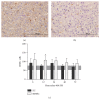Paracrine Effects of Bone Marrow Mononuclear Cells in Survival and Cytokine Expression after 90% Partial Hepatectomy
- PMID: 28326105
- PMCID: PMC5343266
- DOI: 10.1155/2017/5270527
Paracrine Effects of Bone Marrow Mononuclear Cells in Survival and Cytokine Expression after 90% Partial Hepatectomy
Abstract
Acute liver failure is a complex and fatal disease. Cell-based therapies are a promising alternative therapeutic approach for liver failure due to relatively simple technique and lower cost. The use of semipermeable microcapsules has become an interesting tool for evaluating paracrine effects in vivo. In this study, we aimed to assess the paracrine effects of bone marrow mononuclear cells (BMMC) encapsulated in sodium alginate to treat acute liver failure in an animal model of 90% partial hepatectomy (90% PH). Encapsulated BMMC were able to increase 10-day survival without enhancing liver regeneration markers. Gene expression of Il-6 and Il-10 in the remnant liver was markedly reduced at 6 h after 90% PH in animals receiving encapsulated BMMC compared to controls. This difference, however, was neither reflected by changes in the number of CD68+ cells nor by serum levels of IL6. On the other hand, treated animals presented increased caspase activity and gene expression in the liver. Taken together, these results suggest that BMMC regulate immune response and promote apoptosis in the liver after 90% PH by paracrine factors. These changes ultimately may be related to the higher survival observed in treated animals, suggesting that BMMC may be a promising alternative to treat acute liver failure.
Conflict of interest statement
The authors have no conflict of interests to declare.
Figures





Similar articles
-
Hepatocyte growth factor promotes liver regeneration induced by transfusion of bone marrow mononuclear cells in a murine acute liver failure model.J Hepatobiliary Pancreat Sci. 2011 May;18(3):397-405. doi: 10.1007/s00534-010-0343-8. J Hepatobiliary Pancreat Sci. 2011. PMID: 21076985
-
Encapsulated Whole Bone Marrow Cells Improve Survival in Wistar Rats after 90% Partial Hepatectomy.Stem Cells Int. 2016;2016:4831524. doi: 10.1155/2016/4831524. Epub 2015 Nov 16. Stem Cells Int. 2016. PMID: 26649048 Free PMC article.
-
EGFP transgene: a useful tool to track transplanted bone marrow mononuclear cell contribution to peripheral remyelination.Transgenic Res. 2018 Apr;27(2):135-153. doi: 10.1007/s11248-018-0062-5. Epub 2018 Feb 16. Transgenic Res. 2018. PMID: 29453733
-
Encapsulated platelets modulate kupffer cell activation and reduce oxidative stress in a model of acute liver failure.Liver Transpl. 2016 Nov;22(11):1562-1572. doi: 10.1002/lt.24524. Liver Transpl. 2016. PMID: 27509591
-
Mesenchymal Stem Cells Transplantation following Partial Hepatectomy: A New Concept to Promote Liver Regeneration-Systematic Review of the Literature Focused on Experimental Studies in Rodent Models.Stem Cells Int. 2017;2017:7567958. doi: 10.1155/2017/7567958. Epub 2017 Mar 13. Stem Cells Int. 2017. PMID: 28386285 Free PMC article. Review.
Cited by
-
Mesenchymal Stem Cell Transplantation for Liver Cell Failure: A New Direction and Option.Gastroenterol Res Pract. 2018 Mar 4;2018:9231710. doi: 10.1155/2018/9231710. eCollection 2018. Gastroenterol Res Pract. 2018. PMID: 29686702 Free PMC article. Review.
References
-
- Mohamadnejad M., Vosough M., Moossavi S., et al. Intraportal infusion of bone marrow mononuclear or CD133+ cells in patients with decompensated cirrhosis: a double-blind randomized controlled trial. Stem Cells Translational Medicine. 2016;5(1):87–94. doi: 10.5966/sctm.2015-0004. - DOI - PMC - PubMed
LinkOut - more resources
Full Text Sources
Other Literature Sources

